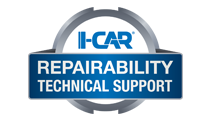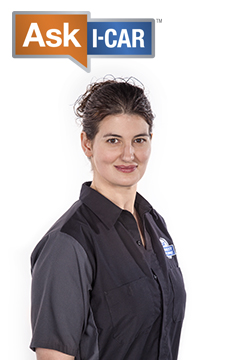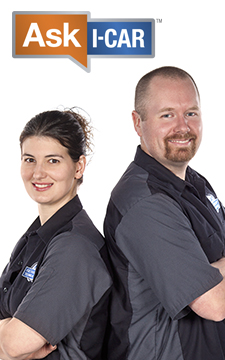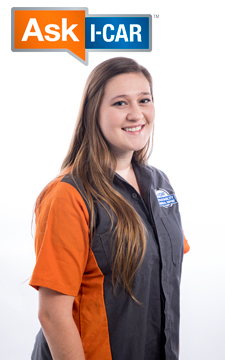OEM Restraints System Part Replacement Search
2008 Pontiac G8
Share:
|
DISABLE PROCEDURE AND TIME (Always Check Service Manual)
1. Turn the steering wheel so that the vehicles wheels are pointing straight ahead.2. Place the ignition in the OFF position.
3. Disconnect the negative battery cable from the battery.
4. Wait 2 minutes before working on system.
REV: 08/2012
PARTS THAT MUST BE REPLACED FOLLOWING A DEPLOYMENT
After a collision with a Frontal Air Bag Deployment, replace the following components:• Driver steering wheel air bag [AIRBAG,STEERING WHEEL]
• Passenger instrument panel air bag, if deployed [AIRBAG,INSTRUMENT PNL]
• Inflatable Restraint Sensing and Diagnostic Module (SDM), if the Inflatable Restraint Sensing and Diagnostic Module has set DTC B0052 and will not clear [MODULE,AIRBAG CONTROL]
• Front [AIRBAG SENSOR,FRONT] and/or side [AIRBAG SENSOR,SIDE] impact sensors
• Driver/Passenger seat side air bag, if deployed [AIRBAG,FRONT SEAT]
• Seat back cover if side seat air bag is deployed
• Driver/Passenger seat belt anchor and/or retractor pretensioners
• Seat belt system in use during a collision serious enough to deploy any automatic restraint device such as airbags and seat belt pretensioners.
After a collision involving driver/passenger side seat [and/or Curtain shield] air bag deployment, replace the following components:
• Driver/Passenger seat side air bag, if deployed [AIRBAG,FRONT SEAT]
• Left/right side impact sensors on the side of the impact. [AIRBAG SENSOR,SIDE]
• Left/right roof rail air bag on the side of the impact. [AIRBAG,ROOF]
• Inflatable restraint sensing and diagnostic module (SDM), if SDM has DTC B0052 56 and will not clear. [MODULE,AIRBAG CONTROL]
• Inflatable restraint seat belt anchor and/or retractor pretensioner
• Driver or passenger seat back cushion cover replacement, if seat airbag deployed
• Seat belt system in use during a collision serious enough to deploy any automatic restraint device such as air bags and seat belt pretensioners.
The impact sensor replacement policy requires replacing sensors in the area of the accident damage. The area of accident damage is defined as the portion of the vehicle which is crushed, bent, or damaged due to a collision. An example of this would be a moderate collision where the front of the vehicle impacts a object. If the vehicle has an impact sensor mounted forward of the radiator, it must be replaced.
• Replace the impact sensor whether or not the air bags have deployed.
• Replace the impact sensor even if it appears to be undamaged.
Impact sensor damage which is not visible, such as slight bending of the mounting bracket or cuts in the wire insulation, can cause improper operation of the SIR system. Do not try to determine whether the impact sensor is undamaged, replace the impact sensor. Also, if you follow a diagnostic trouble code (DTC) procedure and a malfunctioning impact sensor is indicated, replace the impact sensor.
CAUTION: Restraint systems can be damaged in a collision. To help avoid injury and ensure that all parts in need of replacement are replaced:
Replace any seat belt system that was in use during a collision serious enough to deploy any automatic restraint device such as air bags and seat belt pretensioners. This not only includes seat belt systems in use by people of adult size, but seat belt systems used to secure child restraints, infant carriers and booster seats, including LATCH system and top tether anchorages.
Replace any seat belt system that has torn, worn, or damaged components. This not only includes adult seat belt systems, but built-in child restraints and LATCH system components, if any.
Replace any seat belt system if you observe the words "REPLACE" or "CAUTION", or if a yellow tag is visible. Do not replace a seat belt system if only the child seat caution label is visible.
Replace any seat belt system if you are doubtful about its condition. This not only includes adult seat belt systems, but built-in child restraints, LATCH system components, and any restraint system used to secure infant carriers, child restraints and booster seats.
Do NOT replace single seat belt system components in vehicles that have been in a collision as described above. Always replace the entire seat belt system with
the buckle, guide and retractor assembly, which includes the latch and webbing material.
After a minor collision where no automatic restraint device was deployed, seat belt system replacement may not be necessary, unless some of the parts are torn, worn, or otherwise damaged.
PARTS THAT MUST BE INSPECTED AND REPLACED IF DAMAGED
After any collision, inspect the following components as indicated. If you detect any damage, replace the component. If you detect any damage to the mounting points or mounting hardware, repair the component or replace the hardware as needed:• The steering column--Inspect the steering column for bending, twisting, buckling or any type of damage.
• The instrument panel knee bolsters and mounting points--Inspect the knee bolsters for bending, twisting, buckling, or any other type of damage.
• The instrument panel brackets, braces, etc.--Inspect for bending, twisting, buckling, or any other type of damage.
• The seat belts--Perform the seat belt operational and functional checks. Refer to Repairs and Inspections Required After a Collision.
• The instrument panel cross car beam--Inspect for bending, twisting, buckling, or any other type of damage.
• The instrument panel mounting points and brackets--Inspect for bending, twisting, buckling, or any other type of damage.
• The seats and seat mounting points--Inspect for bending, twisting, buckling, or any other type of damage.
• The roof and headliner mounting points.
• The brake pedal --Inspect the brake pedal for bending, twisting, buckling or any type of damage
After a collision involving a frontal air bag deployment, perform additional inspections on the following components:
• Steering wheel air bag coil and the coil wiring pigtail--Inspect for melting, scorching, or other damage due to excessive heat.
• Mounting points or mounting hardware for the passenger instrument panel air bag, steering wheel air bag, SDM, seat side air bag (if deployed) and seat belt anchor and/or retractor pretensioners --Inspect for any damage and repair or replace each component as needed
After a collision involving driver/passenger side air bag deployment, perform additional inspections on the following components:
• Mounting points or mounting hardware for the side impact sensors, and driver/passenger side seat air bags on the side of impact--Inspect for any damage and repair or replace each component as needed.
• Mounting points, mounting hardware, headliner and trim pieces for the left/right roof rail air bag on the side of impact--Inspect for any damage and repair or replace each component as needed.
• Mounting points or mounting hardware for the Inflatable Restraint Sensing and Diagnostic Module and seat belt anchor and/or retractor pretensioners—Inspect for any damage and repair or replace each component as needed.
• The seat cushion frame
• The seat recliner and cover, if equipped
• The seat adjuster
• The seat back frame
• Door trim assembly
• Impacted seat cushion side covers and switches
*This matrix does not currently contain all production vehicles sold in the United States. The contents were developed in cooperation with AudaExplore, a Solera company. The contents are based on the information available at the time of publication. Updates and additions will be posted as they become available. To ensure that you are using the most recent information, always refer to vehicle maker technical information.









